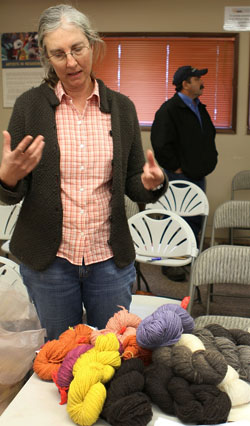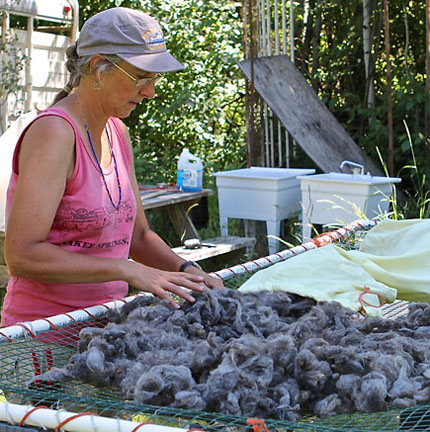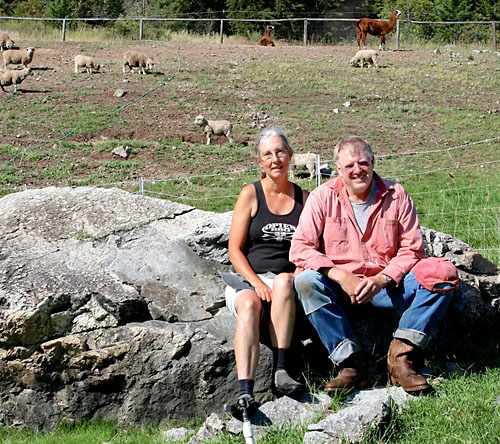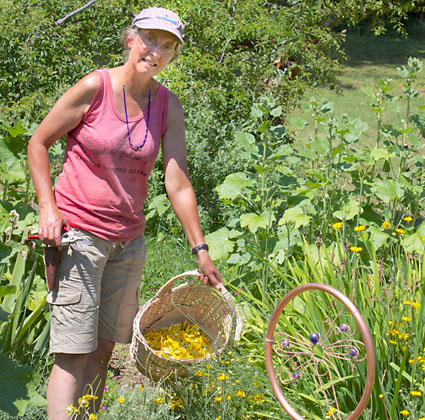home | internet service | web design | business directory | bulletin board | advertise | events calendar | contact | weather | cams

|
 Katie Haven shows classmates in the Sustainable Small Farming course the naturally dyed yarn products she sells. She is involved in every stage of production from delivering the lambs to dying the wool. Katie Haven shows classmates in the Sustainable Small Farming course the naturally dyed yarn products she sells. She is involved in every stage of production from delivering the lambs to dying the wool. PART THREE OF A SERIES Katie Haven grew up in Seattle, joined Sea Scouts and eventually became a chief engineer for the Alaska Marine Highway ferry system. Despite 27 years at sea on container ships, oil tankers and ferries, she says she was “one of those urban people who dreamed about owning a little piece of land somewhere.” Her “somewhere” turned out to be up Poorman Creek outside Twisp, where in 1998 she bought a small piece of land that had a well on it and a little Airstream trailer for shelter. Like so many other new local landowners, Haven later decided to build a small structure with an art studio and living space. But first she needed to find a surveyor to help determine whether her plan was feasible. Searching the Internet while aboard ship in Alaska, she found local surveyor Bill Tackman’s website and liked what she read. “I got my survey along with an invitation to dinner,” she says of their meeting. The rest, as they say, is history. The couple now lives on the McFarland Creek Lamb Ranch, a just-shy-of-25-acre farm up McFarland Creek.  Katie Haven displays fleece that is washed, dried and ready to ship to Spinderella, where it will be processed to her specifications. She designed and built the drying table from PVC pipe, netting and baling twine. Katie Haven displays fleece that is washed, dried and ready to ship to Spinderella, where it will be processed to her specifications. She designed and built the drying table from PVC pipe, netting and baling twine.Tackman, who grew up on a cattle and sheep ranch in Harney County, Oregon near Burns, bought the first piece of McFarland Creek property in the mid-1990s because it came with water rights and a good year around gravity-fed water system, Haven says. And while it’s true he grew up around a cowboy life, Tackman says, “I spent more time with a number two shovel in my hands than I ever did ranging. And I never sat down on a bale of hay and thought how lucky I was because every day was work and the next day was more work.” Although Tackman continues to work as a surveyor and has mainly weekends to do farm projects and chores, “He’s always wanted to just be a rancher,” says Haven, who adds that he’s “working to support his sheep habit.” After commuting to her ship, working one-month on and one-month off, Haven retired from her maritime career in October 2012 to work the ranch fulltime. And because so much ranch work involves digging, she bought herself a retirement gift—a bright blue Holland tractor with a backhoe. She smiles as she points to the model name on the side—Boomer. Haven is 52 and Tackman 57, meaning both are part of the Baby Boom generation. As befits a detail-oriented marine engineer paired with a surveyor, the couple has very specific plans for what they want to accomplish over the next 5, 10 and 20 years. “It’s a big dream, so we’ll see,” Haven told Grist on a recent summer afternoon.  Katie Haven and Bill Tackman sit on one of their favorite perches at their McFarland Creek Lamb Ranch. A few of their sheep and two llamas are visible in the background. Katie Haven and Bill Tackman sit on one of their favorite perches at their McFarland Creek Lamb Ranch. A few of their sheep and two llamas are visible in the background.But just consider a partial list of what the pair has accomplished in the last five years: They purchased an additional 10 acres of land, built a chicken house for about a dozen birds, built a wood shed, established a vegetable garden, planted a vineyard, replaced the irrigation line, built a retaining wall to prevent water from reaching the barn and built waste-free feeder bunks of their own design that help keep their animals’ fleece cleaner. A lifelong knitter, Haven used to make scarves, hats, mittens and socks that she sold at the holiday bazaars. She says she used to listen to the radio and get in three to four hours of knitting a day when it was quiet aboard her ship. “The irony is now that I’ve retired, I haven’t made one scarf in six months,” she adds. Instead she is making and dying yarn that she sells locally at the holiday bazaars, the Mazama Store and online through the farm’s web site, www.thelambranch.com. All the wool comes from the couple’s flock of 38 or so Romney sheep, which are raised for their meat as well as their fleece. When the sheep are shorn in March, before lambing begins in April, each fleece is kept separate so Haven and her eventual customers know the name of the sheep that produced their yarn. It is not quite a total do-it-yourself project. After she washes and dries the fleece, Haven sends it to Spinderella, a family-owned company in Utah that processes it fleece-by-fleece to her specifications.  Katie Haven cuts chamomile blossoms that will be dried and used to dye some of her yarn. A more formal dye-plant garden is on her to-do list, along with years of other work. Katie Haven cuts chamomile blossoms that will be dried and used to dye some of her yarn. A more formal dye-plant garden is on her to-do list, along with years of other work.The natural yarns range in color from white to shades of grey and charcoal black. But Haven also uses natural materials such as carrot tops, Oregon grape, serviceberry, rhubarb, onion skin and dried flowers to create a pallet of naturally-dyed yarns. (She does that yarn work at the studio on her Poorman Creek property.) This is not a get-rich plan, she told her classmates in the Sustainable Small Farm class held in Twisp earlier this year. The ranch is basically “a lifestyle choice,” she said. “We don’t have a big dream to get huge.” What the couple does have is a commitment to at least a decade, probably more, of hard labor. Their five-year plan is to continue their meat and wool business plus build a cabin where their mothers, both in their 80s, can stay while visiting. The cabin would be the first piece in their 10-20 year plan to enter the agritourism business, which gives paying guests a farm experience. (Agritourism is popular in Europe and a growing trend in the U.S.) The five-year to-do list also includes continuing to improve the ranch infrastructure by replacing fencing, building a manure containment area, putting up a greenhouse and developing a fenced dye garden. The couple also plans to replace the shop and perhaps the house, which was started in the 1920s and added onto over the years. A decade from now Haven and Tackman hope to have several guest cabins operating, an improved fire pit for roasting lamb, a patio and their own micro-hydropower plant. Haven says the ranch is the site of an old power plant that once fed electricity to a pioneer schoolhouse. The goal within two decades, Haven told her classmates, is to have everything in good enough condition that they can maintain it—that includes a flock of about 15 ewes, which will give them 20 or so lambs a year. “We just plug along,” the understated Haven said of the physical work the ranch requires. The labor might be daunting to many urban transplants, but Haven said she’s always been a physically active person. “When we get overwhelmed and wonder why in the hell we’re doing all this, we have a big family and friends gathering and roast a lamb,” she says, and then it all seems worthwhile.
Next (in part four): Meet Jane Gilbertsen, a retired Seattle attorney, who is raising heritage chickens in an extraordinary array of coops and encouraging others to raise non-factory poultry. 8/21/2013 Comments
|

